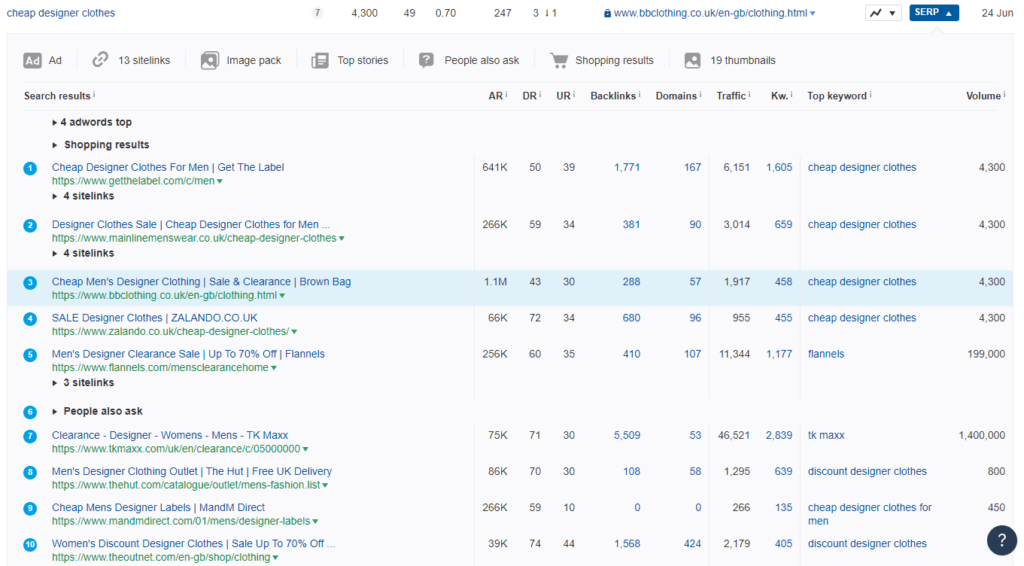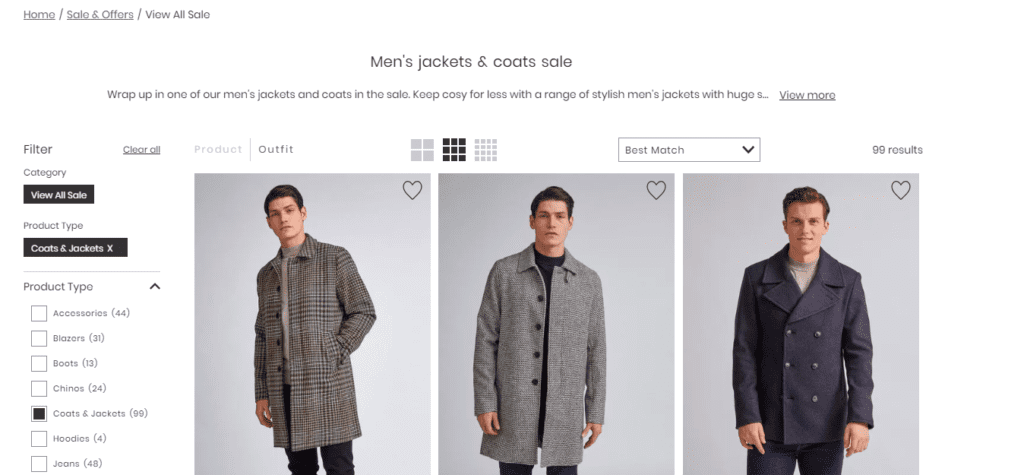In our 2019 sector report of the men’s clothing industry, we broke down the market and discovered who’s performing the best online. There were a lot of winners and a few losers, as you’d expect. However, one brand stood out from the rest. BBclothing.co.uk, also known as Brown Bag, had seen a visibility increase of 349% YoY. They had climbed from 30th to 14th in 12 months.
With all this data, Brown Bag had to be doing something different to get ahead of all these monster brands in the SERPs. Men’s fashion is a competitive industry, yet Brown Bag had surpassed many of them despite a lower domain authority of 40 (at the time).
In this article, you’ll discover how Brown Bag achieved this and the search term they’re targeting to make it all possible. Unfortunately, it’s a term the men’s fashion (specifically, designer fashion) industry tries to avoid. Brown Bag have ignored this and used it to their advantage.
The One Word That Changed Their SEO Strategy
When we looked at Brown Bag in more detail, it was clear why they had risen to stardom so quickly. They had suddenly started ranking for a ton of keywords that no other brand (with the exception of Mainline Menswear) was attempting to go for.
The keywords were not something all menswear brands would care to rank for. Yet, they provide a ton of search volume and provide an angle that allows them to slip past the competition.
What is this keyword you ask?
Basically, Brown Bag have added the term ‘cheap’ to the front of nearly all their title tags, especially for designer brands that would normally be pricy.
Here’s a snapshot of their top-ranking keywords:

If you look closely, nearly all of them are revolving around the term ‘cheap [insert designer brand]’. And when you look at the SERPs for those keywords, other men’s clothing brands are nowhere to be found.
The only other brand to get a spot for these keywords is Mainline Menswear. The rest are large general brands such as TKMaxx and Get The Label.
Check out the SERP environment for their most valuable keyword – ‘cheap designer clothes’:

Despite a weak authority, they manage to keep up with the bigger, more authoritative sites. All because they specifically target keywords modified with the operator ‘cheap’.
When you exclude any keyword based on the phrases ‘sale’ and ‘cheap’, their ranking keywords drop from 11K to 8K. Although they still rank for many keywords without the word ‘cheap’, it’s a significant drop.
How Brown Bag Uses This Keyword in Their SEO
If you haven’t already noticed how Brown Bag are using this little phrase, look closer at the picture above. They’re including the word in their title tag on nearly every money page on their site.
Although the word escapes their on-page copy, the prevalence they put on it using the title tag seems to be enough to get these pages ranking for designer-related terms.

As well as the word ‘cheap’ they also use synonyms in their meta data, including words like ‘discount’ and ‘sale’. As you can see, Google gives these weight as they highlight them within the SERPs as you can see with the above screenshot.
All these add-up to targeted meta data that clearly helps them rank.
Problems Using This Keyword
So, why doesn’t everyone include this in their category pages?
The problem is that many brands don’t want to rank for terms that could devalue their clothes. Additionally, many of the clothes in their categories are listed as full price without a discount, so it wouldn’t really make sense to include this word in the title tag if it isn’t true.
The former point, however, requires more of a mental shift opposed to a physical shift. By refusing to either change title tags to encompass price-related keywords, you could be missing out on a ton of traffic. Traffic that is commercially charged as well. Just because the audience is searching for cheap clothes doesn’t mean they’re not buyers.
If you’re concerned that you’ll be devaluing your brand by marking categories as ‘cheap’, I suggest you simply give it an experiment and see how it effects brand sentiment. You may find that it doesn’t influence how people perceive the brand and will enable you to achieve better search visibility.
Of course, there are other sneakier ways you can implement this into your SEO strategy.
How Can Men’s Fashion Brands Mimic Brown Bags Success with Price-Related Terms?
A simple way any brand could mimic Brown Bag’s strategy is by creating two sub-categories for each clothing item. In one sub-category, you’ll have the full priced items. In the other, you’ll have the discounted or sale items.
For example, if you were selling men’s jackets, you could have one category targeting men’s jackets, and another targeting cheap men’s jackets.
Now, there are problems associated with this approach. Mainly that it could cause duplicate content issues. However, many brands already have something like this set up.
Take Burton, for example:

They have sale categories but aren’t targeting keywords like ‘cheap’ or ‘discounted’ in their copy or meta data. This is a missed opportunity.
However, Burton don’t have “designer” clothes, such as HUGO or True Religion, so ranking for designer-based keywords might not align with their brand image.
Of course, there is an easier way to do all this…
You could simply place the word ‘cheap’ and synonyms of the same in pre-existing clothing categories. This would allow you to keep the authority of existing categories and get them ranking in price-related keywords like Brown Bag.
However, as for reason discussed above, some brands may feel this isn’t the right move for them.
Could Extraneous Variables Be the True Cause of Brown Bag’s Increase?
Although it’s very clear Brown Bag gets a good proportion of its visibility from price-related keywords, there is still visibility resulting from other variables.
Yes, these keyword changes must have had an impact on their visibility, but could there be something else we’re missing?
From an architectural point of view, they haven’t got the cleanest site structure. Their URLs are also a bit of a mess. It’s safe to say they aren’t conveying a lot of trust from this angle.
Also, their Largest Contentful Paint came in at 3 seconds when I first loaded the page. Not ideal.
Furthermore, they don’t have a blog or any sort of on-site content marketing. So, it’s difficult to comment on whether there are other content assets at play here.
What all of this is telling me, is that their keyword usage has to be having a significant impact on their visibility score, particularly the one we witnessed last year in the men’s clothing report.
If we were able to perform a proper in-depth audit of the site, other influencing factors may be identified. For the meantime, however, we have to go on what we can see.
Summary
It’s safe to say that Brown Bag has surprised us. Despite having a small domain authority and being a smaller site, they have beaten many sites in the game of visibility.
They’ve successfully utilised price-related keywords to get ahead of the competition and are reaping the rewards as a result.
If you want our expert team to dive into your site to see what makes it tick (and how it can tick better) call now on 0800 122 3530.
